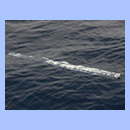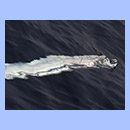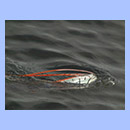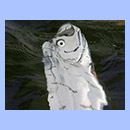- Kingdom: Animalia
- Phylum: Chordata
- Subphylum: Vertebrata
- Superclass: Gnathostomata
- Class: Actinopterygii
- Order: Lampriformes
- Family: Regalecidae
- Scientific name: Regalecus glesne
- Norwegian: sildekonge
Characteristics:
No, it is not the Loch Ness monster, although there are plenty of histories of sea serpents from all over the world originating from oarfish observations. The oarfish is the longest bony fish we know, it is well documented that it can reach 8 meters, but specimens 17 meters in length have been reported.
The compressed ribbon-like body has a silvery color crossed by dark, vertical lines. The dorsal fin runs along the entire body. The first finrays are bright red and highly elongated.
Habitat:
The size along should be sufficient to scare a heart attack on any diver or swimmer lucky enough to encounter one. The chances are slim though, as it usually operates on a depth range from 200 to 1000 meters. Sometimes dying oarfish are washed onto a beach or found floating in the surface. The latter was the case with the individual presented here. It was found standing vertically in the water during a whale safari outside the coast of San Miguel (the Azores). It was still moving, but clearly in trouble as parts of the tale seemed to be missing. Perhaps it was bitten off by a toothed whale. The remaining oarfish was approximately 3 meters long.
Distribution:
These pictures are the only ones taken outside Norway on this website. However, I can safely include the oarfish in the Norwegian marine fauna. In fact, the first registered oarfish observation was made by the Dane Ascanius in 1765 and 1769 at Glesvær (from which the Latin name is derived), a small village on the west coast of Norway.
It is found in most tropical and temperate seas around the world, but is also registered in the North-East Atlantic Ocean.



